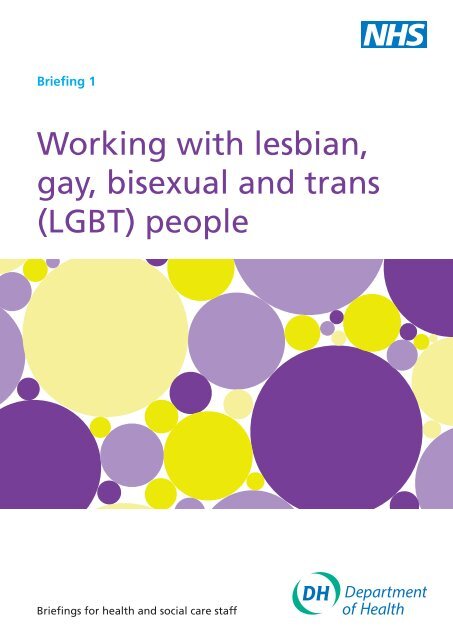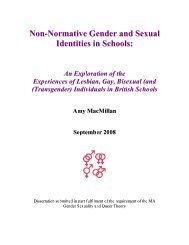Reducing health inequalities for LGBT: Briefing 1 - Schools Out
Reducing health inequalities for LGBT: Briefing 1 - Schools Out
Reducing health inequalities for LGBT: Briefing 1 - Schools Out
You also want an ePaper? Increase the reach of your titles
YUMPU automatically turns print PDFs into web optimized ePapers that Google loves.
<strong>Briefing</strong> 1<br />
Working with lesbian,<br />
gay, bisexual and trans<br />
(<strong>LGBT</strong>) people<br />
<strong>Briefing</strong>s <strong>for</strong> <strong>health</strong> and social care staff
(a) Who are <strong>LGBT</strong> people?<br />
You cannot necessarily tell whether someone is lesbian, gay or bisexual<br />
(LGB) from just their appearance. LGB people come from all walks of<br />
life: they could be old or young, Black and minority ethnic (BME) people,<br />
women, disabled, from any class, or any faith group. They may be in a civil<br />
partnership with a person of the same sex (or even be married to a person<br />
of the opposite sex) and they may have children. They may also be asylum<br />
seekers, refugees, homeless, prisoners or people living in poverty. There are<br />
many LGB people working in <strong>health</strong> and social care services.<br />
‘Trans’ (T) is an umbrella term <strong>for</strong> people whose identities do not con<strong>for</strong>m<br />
to typical ideas about sex and gender. Trans includes transgender,<br />
transsexual and intersex people (see also <strong>Briefing</strong> 11). Trans people may be<br />
heterosexual, lesbian, gay or bisexual; they may be disabled; they may be<br />
old or young; or they could be from BME communities.
(b) What are <strong>LGBT</strong> people’s <strong>health</strong><br />
needs?<br />
Healthcare and other professionals commonly assume that LGB people’s<br />
<strong>health</strong> needs are the same as those of heterosexual people, unless their<br />
<strong>health</strong> needs are related to sexual <strong>health</strong>. LGB people do have unique<br />
<strong>health</strong>care concerns. They report that they are often treated differently<br />
in the <strong>health</strong> sector. Furthermore, discrimination, homophobia and<br />
heterosexism 1 (the belief that heterosexuality is naturally superior to<br />
homosexuality or bisexuality) have an impact on LGB people’s everyday<br />
lives. LGB people are more likely to be victims of violence and verbal abuse.<br />
Young LGB people experience increasing levels of homophobic bullying in<br />
schools.<br />
When young LGB people ‘come out’ to their family, they may even be<br />
<strong>for</strong>ced to leave home. Levels of homelessness among young LGB people are<br />
a continuing problem. LGB people are more likely to live in private sector<br />
housing on short-term leases; some LGB people report problems in finding<br />
accommodation because of their sexual orientation. 2 These (and other)<br />
social determinants can adversely affect the <strong>health</strong> status of LGB people.<br />
Like LGB people, trans people often meet with discrimination and prejudice<br />
in their everyday lives. They can experience social isolation and face limited<br />
understanding of their lives. These experiences place many trans people at<br />
risk of alcohol abuse, depression, suicide and self-harm, violence, substance<br />
misuse and HIV infection.<br />
These <strong>Briefing</strong>s make recommendations <strong>for</strong> improving access to <strong>health</strong><br />
and social care <strong>for</strong> <strong>LGBT</strong> people (see <strong>Briefing</strong> 2) and address <strong>health</strong> issues<br />
relating to key life stages and groups of <strong>LGBT</strong> people, including younger and<br />
older LGB people’s <strong>health</strong>, specific <strong>health</strong> issues within <strong>LGBT</strong> communities,<br />
BME LGB people and disabled LGB people (<strong>Briefing</strong>s 3, 4, 5, 6, 7, 11, 12<br />
and 13). They also bring together available evidence of <strong>health</strong> <strong>inequalities</strong> in<br />
relation to substance misuse, mental <strong>health</strong> and sexual <strong>health</strong> (<strong>Briefing</strong>s 8,<br />
9 and 10).
(c) Barriers to <strong>LGBT</strong> <strong>health</strong>care<br />
Attitudes and behaviour of <strong>health</strong> and social care providers<br />
Although homophobia and transphobia seem to have become less common, studies suggest that up<br />
to 25% of <strong>health</strong> service staff have expressed negative or homophobic attitudes. 3 There is evidence<br />
to suggest that <strong>health</strong>care staff and organisations have been judgemental and unsupportive towards<br />
<strong>LGBT</strong> people who use services, and that such attitudes mean that <strong>LGBT</strong> people do not receive effective<br />
<strong>health</strong> and social care. 4 In comparison, heterosexual people are much less likely to report adverse<br />
experiences of <strong>health</strong>care.<br />
Obstacles to communication with <strong>health</strong>care providers<br />
Many <strong>LGBT</strong> people fear that if they disclose their sexual orientation or gender identity status to a<br />
<strong>health</strong>care worker, they will receive discrimination and poorer treatment. Instead, many LGB people<br />
choose to stay ‘in the closet’ (ie they pretend to be heterosexual) and trans people may not access<br />
<strong>health</strong>care services. 5<br />
Research indicates that over half of gay men had not disclosed their sexual orientation to their GP even<br />
though GPs could deliver more appropriate <strong>health</strong>care if they knew. 6 A number of factors influence<br />
whether or not LGB people will come out, including confidentiality of patient records, and how<br />
in<strong>for</strong>mation is recorded and who will have access to patient records (including employers, mortgage<br />
providers and insurance companies). They also may fear lower standards of care or a negative<br />
or inappropriate response where a <strong>health</strong> problem may be attributed to their sexual orientation.<br />
Staff knowledge and understanding of <strong>LGBT</strong> <strong>health</strong> issues<br />
There is a lack of knowledge and awareness among NHS staff about <strong>LGBT</strong> <strong>health</strong> needs; the<br />
undergraduate medical curriculum, nursing education and the training of allied <strong>health</strong> professionals<br />
include little input about sexual orientation. 7 GPs do not always know the questions to ask and their<br />
personal feelings may <strong>for</strong>m a barrier to open discussion. Research highlights the need <strong>for</strong> training and<br />
experiential learning opportunities (eg the use of role play). 8<br />
Delayed attendance and reduced screening<br />
The three issues identified above – attitudes, communication and<br />
knowledge – mean that LGB people delay seeking help <strong>for</strong> a <strong>health</strong><br />
problem and are less likely to access routine <strong>health</strong> screening. This includes<br />
breast and cervical screening <strong>for</strong> women, and presenting with early signs<br />
of prostate or anal cancer <strong>for</strong> men. It also means that LGB people are less<br />
responsive to preventative <strong>health</strong>care messages because they think the<br />
<strong>health</strong> sector has little to offer them.<br />
Delays in provision of care<br />
For trans people, the biggest barriers include waiting times <strong>for</strong> surgery<br />
<strong>for</strong> gender reassignment and inappropriate general <strong>health</strong>care.
(d) Policy/legislation: what you need to know<br />
In a speech marking <strong>LGBT</strong> History Month in February 2006, Sir Liam Donaldson, the Chief Medical<br />
Officer, acknowledged the <strong>health</strong> <strong>inequalities</strong> experienced by <strong>LGBT</strong> communities and cited UK <strong>health</strong><br />
and social care needs assessments which revealed evidence of need.<br />
This speech and other in<strong>for</strong>mation about the Department of Health’s work on sexual orientation and<br />
gender identity are available at:<br />
www.dh.gov.uk/en/Policyandguidance/Equalityandhumanrights/Sexualorientationandgenderidentity/<br />
index.htm<br />
Employment Equality (Sexual<br />
Orientation) Regulations 2003<br />
These Regulations prevent employers refusing to<br />
employ people because of their sexual identity;<br />
they also protect workers from direct abuse and<br />
homophobia from colleagues. This legislation<br />
should reduce workplace discrimination and<br />
harassment.<br />
Gender Recognition Act 2004<br />
This legislation af<strong>for</strong>ds full legal recognition to a<br />
trans person’s acquired gender which does not<br />
depend on medical treatment. The Act allows<br />
new birth certificates <strong>for</strong> trans people which<br />
recognise their new gender, and the right to<br />
marry can no longer be refused.<br />
Domestic Violence, Crime and Victims<br />
Act 2004<br />
The Act recognises that same-sex couples<br />
experience domestic abuse.<br />
Choosing Health<br />
The Choosing Health White Paper 9 puts in<br />
place the foundations <strong>for</strong> national and local<br />
NHS service planning and commissioning<br />
arrangements that recognise the needs of all<br />
parts of the population, and aims to develop<br />
services that reduce <strong>health</strong> <strong>inequalities</strong>.
Civil Partnership Act 2005<br />
The Act offers the same treatment in a wide<br />
range of <strong>health</strong> and legal matters to same-sex<br />
couples who <strong>for</strong>m a civil partnership as oppositesex<br />
couples who enter into a civil marriage.<br />
Our Health, Our Care, Our Say<br />
This White Paper 10 integrates a range of <strong>health</strong><br />
and social care planning, funding, system<br />
re<strong>for</strong>m and practice development measures to<br />
improve <strong>health</strong> outcomes and reduce <strong>inequalities</strong><br />
experienced by disadvantaged and minority<br />
groups.<br />
Equality Act (Sexual Orientation)<br />
Regulations 2007<br />
The Regulations, which came into <strong>for</strong>ce on<br />
30 April 2007, prohibit discrimination on the<br />
grounds of sexual orientation in the provision of<br />
goods and services (including <strong>health</strong> and social<br />
care). They cover public, private and voluntary<br />
organisations.<br />
This means, <strong>for</strong> instance, that a gay man cannot<br />
be turned away from a GP practice on the<br />
grounds of his sexual orientation, or a woman<br />
cannot be refused a smear test or testing <strong>for</strong><br />
sexually transmitted infections because she is a<br />
lesbian. It also means that when a primary care<br />
trust provides a ‘service’ <strong>for</strong> heterosexual people,<br />
if appropriate, they should also provide a service<br />
<strong>for</strong> LGB people.
(e) Links and resources<br />
Albert Kennedy Trust<br />
Supporting <strong>LGBT</strong> homeless young people.<br />
www.akt.org.uk<br />
Broken Rainbow<br />
Support <strong>for</strong> <strong>LGBT</strong> people experiencing domestic<br />
violence.<br />
www.broken-rainbow.org.uk<br />
Department of Health Sexual Orientation<br />
and Gender Identity Advisory Group<br />
The Department is currently working with<br />
external stakeholders on the delivery of a<br />
programme of work to promote equality and<br />
eliminate discrimination <strong>for</strong> <strong>LGBT</strong> people in<br />
<strong>health</strong> and social care (as both service users<br />
and employees).<br />
www.dh.gov.uk/equalityandhumanrights<br />
GALOP<br />
London’s <strong>LGBT</strong> community safety charity.<br />
www.galop.org.uk<br />
Press For Change<br />
Campaigning <strong>for</strong> respect and equality of all<br />
trans people.<br />
www.pfc.org.uk<br />
Stonewall<br />
LGB campaigning organisation. Provides<br />
in<strong>for</strong>mation about research on LGB <strong>health</strong><br />
and social care needs.<br />
www.stonewall.org.uk/in<strong>for</strong>mation_bank/<strong>health</strong>/<br />
default.asp
(f) References<br />
1. Fish, J (2006) Heterosexism in Health and<br />
Social Care, Palgrave Macmillan, Basingstoke.<br />
Chapter 1 presents an analysis of both<br />
homophobia and heterosexism.<br />
www.palgrave.com/newsearch/Catalogue.<br />
aspx?is=1403941238<br />
2. Leicester Lesbian, Gay and Bisexual Centre<br />
(2005) Sexyouality Matters: Sexuality Matters<br />
Community Strategy. A strategy <strong>for</strong> improving<br />
the lives of <strong>LGBT</strong> people in Leicester, LLGBC,<br />
Leicester.<br />
www.llgbc.com<br />
3. Beehler, GP (2001) Confronting the Culture of<br />
Medicine: Gay Men’s Experiences with Primary<br />
Care Physicians, Journal of the Gay and Lesbian<br />
Medical Association, 5(4): 135–41.<br />
4. Scott, P (2001) Small Ef<strong>for</strong>t, Big Change – A<br />
general practice guide to working with gay and<br />
bisexual men, Gay Men’s Health Wiltshire and<br />
Swindon, Swindon/Salisbury.<br />
www.gmhp.demon.co.uk/index.html<br />
5. Bell, N and Morgan, L (2003) First out: Report<br />
of the Beyond Barriers survey of lesbian, gay,<br />
bisexual and transgender people in Scotland,<br />
Beyond Barriers, Glasgow.<br />
www.beyondbarriers.org.uk<br />
7. Pringle, A (2003) Towards a Healthier <strong>LGBT</strong><br />
Scotland, Stonewall Scotland and NHS Scotland,<br />
Glasgow.<br />
www.lgbt<strong>health</strong>scotland.org.uk/documents/<br />
Towards_Healthier_<strong>LGBT</strong>_Scot.pdf<br />
8. Hinchliff, S, Gott, M and Galena E (2005)<br />
‘I daresay I might find it embarrassing’: General<br />
practitioners’ perspectives on discussing sexual<br />
<strong>health</strong> issues with lesbian and gay patients,<br />
Health and Social Care in the Community, 13(4):<br />
345–53.<br />
9. Department of Health (2004) Choosing Health:<br />
Making <strong>health</strong>y choices easier, Department of<br />
Health, London.<br />
www.dh.gov.uk/en/Publicationsandstatistics/<br />
Publications/PublicationsPolicyAndGuidance/<br />
DH_4094550<br />
10. Department of Health (2006) Our Health, Our<br />
Care, Our Say: A new direction <strong>for</strong> community<br />
services, Department of Health, London.<br />
www.dh.gov.uk/en/Publicationsandstatistics/<br />
Publications/PublicationsPolicyAndGuidance/<br />
DH_4127453<br />
6. Keogh, P, Weatherburn, P, Henderson, L, Reid,<br />
D, Dodds, C and Hickson, F (2004) Doctoring<br />
gay men: Exploring the contribution of General<br />
Practice, Sigma Research, Portsmouth.<br />
www.sigmaresearch.org.uk/reports.html<br />
This <strong>Briefing</strong> was written by Dr Julie Fish as part of<br />
the Department of Health’s Sexual Orientation and<br />
Gender Identity Advisory Group’s work programme.<br />
Crown copyright 2007<br />
283255/1 1p 5k Aug 07 (CWP)<br />
Produced by COI <strong>for</strong> the Department of Health<br />
www.dh.gov.uk/publications







